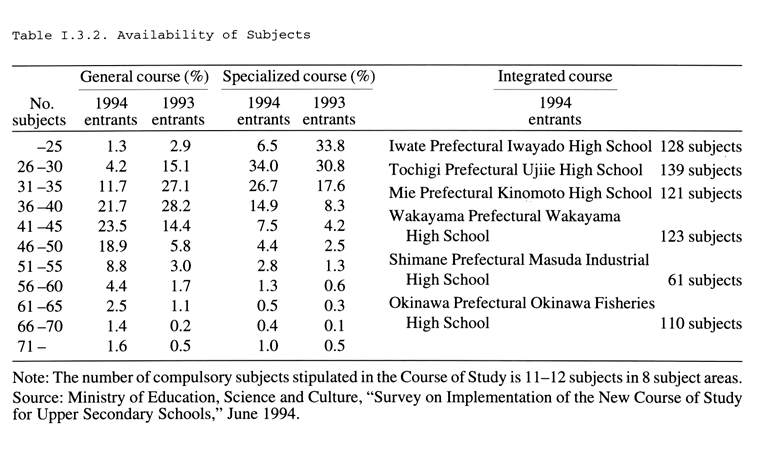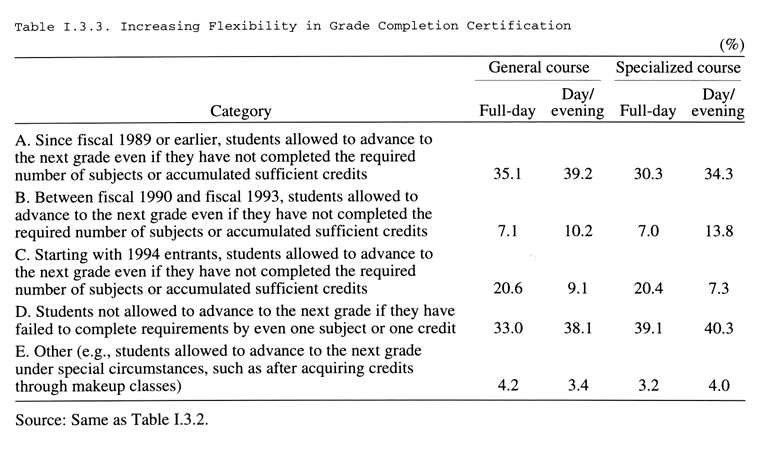| Home > Policy > White Paper, Notice, Announcement > White Paper > JAPANESE GOVERMENT POLICICIES IN EDUCATION, SCIENCE AND CULTURE 1994 > PART I Chapter 3 1 3 | ||
As discussed earlier in this section, the Course of Study for Upper Secondary Schools, which was amended in March 1989 and applied to the April 1994 entrants, is designed to provide solutions to a variety of issues facing upper secondary education; to anticipate social change, including the advent of an era of lifelong learning; and to improve upper secondary education. The main goals of the new Course of Study are to foster the willingness to learn independently and the ability to cope positively with social change, to enhance the ability of education to develop individuality, and to enhance education regarding the requirements of a fully human life and approaches to life. In addition to the improvement of educational content in order to respond appropriately to students' diverse needs and to social change, the Course of Study calls for the encouragement of educational activities that utilize the ideas, ingenuity, and distinctive characteristics of individual schools. Some of the specific components of the new Course of Study are outlined below.
The new Course of Study gives priority to the basic aspects of education essential to life as a citizen of Japan. This emphasis is reflected in the increased care with which the content of subject areas and subjects is selected, while efforts are being made to maintain consistency with lower secondary education. Priority is also given to the development of various abilities, including thought, judgment, and self-expression, through various subject areas and subjects and to the encouragement of scholastic activities that foster students' creativity and imagination, such as exploratory activities, project studies, and theme-oriented learning. Following are some of the improvements that are being made through the restructuring of subject areas and subjects.
In addition to the provision of a diversity of subject areas and subjects to meet the educational needs of students with varying characteristics and career paths, it is necessary to ensure that options are not determined by schools but that students themselves are able to choose freely from the widest possible range of subjects. For this reason, the subject areas and subjects specified for general courses in the Course of Study have been increased from 45 subjects in 8 subject areas to 62 subjects in 9 subject areas, and those for specialized courses from 157 subjects in 6 subject areas to 184 subjects in 6 subject areas.
Furthermore, schools can establish subject areas and subjects other than those specified in the Course of Study if necessitated by local conditions or those of schools and students, the special characteristics of subjects, and so on. In the past this was allowed only under quite limited conditions, but it has now become more widely possible. There have also been changes to the so-called compulsory elective subject system, which enables students to choose from a range of compulsory subjects. Previously this system was limited to "fine arts," but it has now been extended to "geography and history," "civics," "science," and "home economics" to provide increased scope to configure curricula that reflect students' specific needs.
In fiscal 1994 most schools were offering 36-40 subjects to students enrolled in fiscal 1993 and 41-45 subjects to students enrolled in fiscal 1994 in the case of general courses. In the case of specialized courses, most schools offered 25 or fewer subjects to students enrolled in fiscal 1993, but more schools were offering 26-30 subjects to students enrolled in fiscal 1994. An extremely wide range of subjects is offered under the integrated course, which is discussed in detail in section 2 ( Table I.3.2 Availability of Subjects ).
Subjects that are not specified in the Course of Study ("other subjects") are offered by 17.5% of schools offering general courses and by 25.6% of schools offering specialized courses. Such subjects as "international understanding," "information," and "welfare" are offered as "other required subject areas" by 5.0% of schools providing general courses and by 2.2% of schools providing specialized courses. It is clear from these figures that schools are striving to increase the number of subjects available, in line with the aims of the new Course of Study.

The standard curriculum for subject areas and subjects in full-day courses calls for 35 weeks of instruction per year. The new Course of Study, however, stipulates that instruction can be provided during specific terms or periods if required. This approach allows a variety of innovations, including not only practical subjects, such as "comprehensive practical fishery," but also intensive classes featuring instruction by part-time outside lecturers. Provision has also been made for greater flexibility in classes. For example, in addition to the standard unit hour of 50 minutes, it is now possible to set units of 90 or 100 minutes to suit the specific characteristics of each subject.
>From the viewpoint of maximizing students' individual abilities, it is not always appropriate uniformly to prevent students who have failed only a few subjects from advancing to the next grade (grade repetition). In addition, this approach can easily cause students to drop out of school. The new Course of Study therefore stipulates that students should be treated as flexibly as possible, and that instead of requiring students to repeat grades under a uniform system, provision should be made for them to graduate provided that they can accumulate the required number of credits by the time of graduation.
A survey of public upper secondary schools throughout Japan shows that progress is being made toward greater flexibility in grade completion certification. Starting with 1994 entrants, a significant number of schools now allow students to advance to the next grade even if they have not completed the required number of subjects or accumulated sufficient credits ( Table I.3.3 ).
In the past many schools structured curricula that exceeded the standards stipulated in the Course of Study in terms of standard unit hours per week (32 unit hours) and credits required for graduation (80 credits). The June 1994 survey on curriculum structuring in public upper secondary schools conducted by the Ministry of Education, Science and Culture shows that schools are working to bring their class hours and number of credits required for graduation closer to standard levels than in the past, in order to achieve a more appropriate student workload and more relaxed school life.

| Back to Top | MEXT HOME |